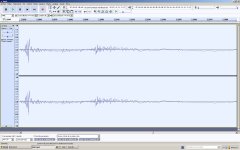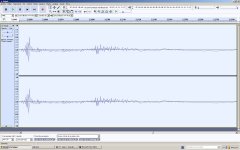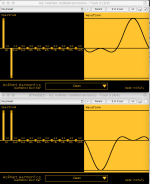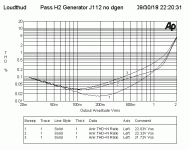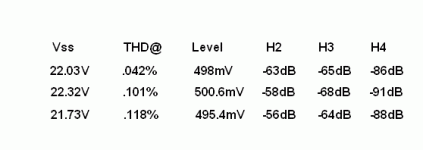Probably H2 generators do not mate very well with some regular multiways. Best bet would be with system with single driver or woofer assisted wideband like the open baffle Papa showed at BAF 2013. At the very least least avoid any crossover point less than 2 octaves to 1 kHz, further is better to avoid phase induced problems masking spatial cues.
Probably H2 generators do not mate very well with some regular multiways. Best bet would be with system with single driver or woofer assisted wideband like the open baffle Papa showed at BAF 2013. At the very least least avoid any crossover point less than 2 octaves to 1 kHz, further is better to avoid phase induced problems masking spatial cues.
There is something about that.
Classic multi way not often impress me when H2 is there.
So far, for me, best multi way that positively react to H2 is Dynaudio Focus 360. Whats the trick I can only speculate,.... compensated impedance or 1st order cross over.
Full range line array with 3.3" drivers, without passive cross over and with enough wide baffle, sound crazy with H2, unbelievable.
Just my experience.....
Here I zoom in on the shape of the input and output signals, around signal levels that cause the circuit to distort with a defined ratio of spectral harmonics similar to those proposed by Nelson Pass. Clearly there is a change of character of the signal in the levels that cause a distortion of around 0.9% (in the oscillograms and for my particular circuit are the levels close to 0.5 volts). For all other lower levels, the signal suffers zero or very little change in its amplitude envelope.
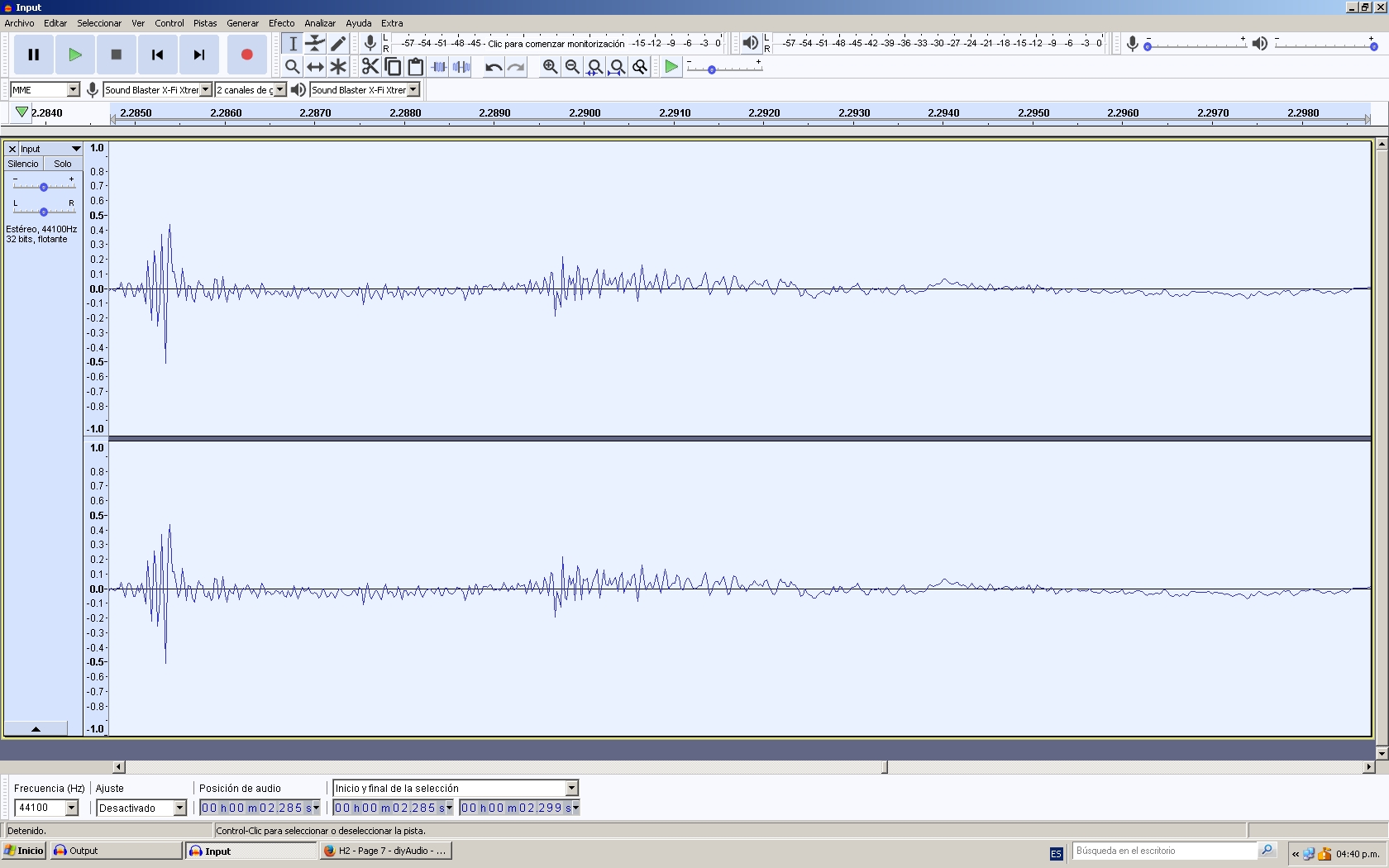
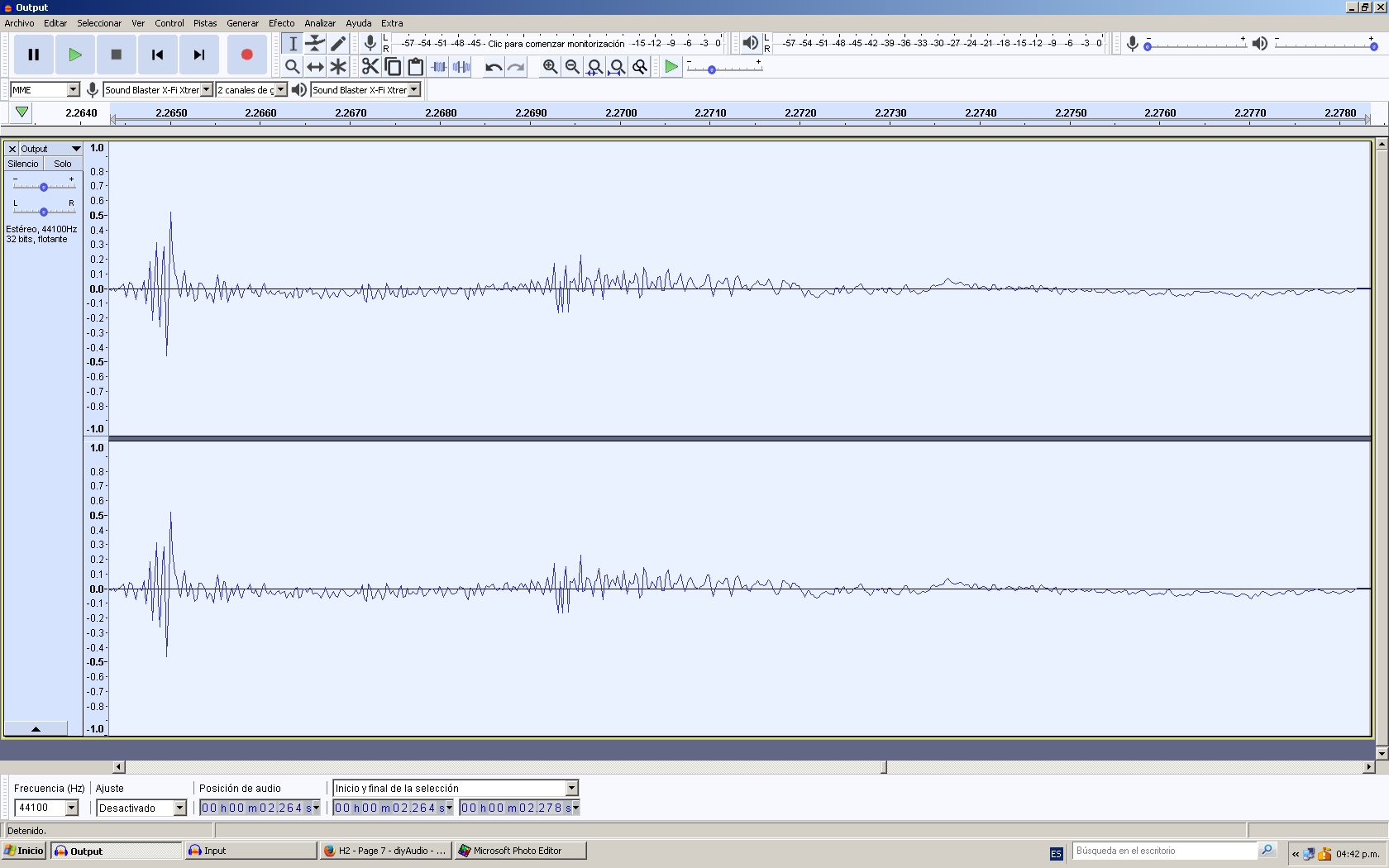
Best regards
Diego
Best regards
Diego
Attachments
Probably H2 generators do not mate very well with some regular multiways. Best bet would be with system with single driver or woofer assisted wideband like the open baffle Papa showed at BAF 2013. At the very least least avoid any crossover point less than 2 octaves to 1 kHz, further is better to avoid phase induced problems masking spatial cues.
Interesting. I will insert harmonics plugins AFTER crossover EQ. I was inserting harmonics plugins BEFORE crossover EQ when I tested them before.
Testing. I find this is a very useful plugin for listening to the effect of distortion, and it's free.
HoRNet Harmonics, free waveshaper VST, AAX and Audio units plugin
The difference between positive and negative H2, and before/ after crossover is clearly heard, but...
It's hard to "directly" compare before/after crossover because of the input signal level differences. The plugin's distortion behavior is very different before/after crossover. If the test is done with the real multi-amp setup, the result would be the same...
The subjective impression about the sound is, one of the H2 phase is clearly preferable to the other phase, and post crossover insertion (after crossover) sounds better than pre-crossover insertion. The speaker units are precisely time alined, but the possible problem is the amp is Aleph J (H2). I'll do some more test next week with digital amp (no H2) if I have time to do it...
HoRNet Harmonics, free waveshaper VST, AAX and Audio units plugin
The difference between positive and negative H2, and before/ after crossover is clearly heard, but...
It's hard to "directly" compare before/after crossover because of the input signal level differences. The plugin's distortion behavior is very different before/after crossover. If the test is done with the real multi-amp setup, the result would be the same...
The subjective impression about the sound is, one of the H2 phase is clearly preferable to the other phase, and post crossover insertion (after crossover) sounds better than pre-crossover insertion. The speaker units are precisely time alined, but the possible problem is the amp is Aleph J (H2). I'll do some more test next week with digital amp (no H2) if I have time to do it...
Attachments
Last edited:
Could you repeat the test with Mr. Pass +/-0.3V range around the 21.96V, being the range 21.66...21.96...22.26V?
The J112 I'm using measured Idss 48mA and Pinchoff Voltage 3.65V. In the circuit it runs around 50 degrees C. Today, the null point is running around 22.03V. Hard to set the power supply with more than 10mV accuracy.
I was wrong in my earlier statement. When Vss is higher than the null point, the phase is negative. When Vss is lower than the null point, phase is positive.
Attachments
After dinner, I did a bit more accurate listening test (still a casual test). With above plugin, We can hear ONLY H2 signal without complicated opposite phase sum connection.
I roughly matched the level of pre and post-crossover H2, and recorded ONLY H2 signal with Logitech Webcam mic which I think is enough to tell the difference. Speaker is precisely time alined 2 way (650Hz Crossover).
1. Pre-Crossover (Linear Phase Crossover)
Theoretically closest to full range.
2. Pre-Crossover (Analog Phase Crossover).
Can you hear slight phase congestion buildup around crossover point?
3. Post-Crossover (Linear Phase Crossover)
Post-Crossover H2 has obvious dip at crossover point because the input level of the H2 generator at that frequency is lower. Also H2 of 500Hz (which is 1K) is less audible due to HF limit of the woofer. So basically, less midrange H2 with post-crossover H2.
3. Post-Crossover II (Linear Phase Crossover, More Woofer H2)
Same as 3, but woofer H2 level is raised. Subjectively, this is the most tubelike sounding option for today's brief test. Good thing about post crossover H2 generator would be we can control the level of H2 of each speaker unit.
The music is copyrighted. I think they are distorted enough to upload here, but if not, please remove them.
I roughly matched the level of pre and post-crossover H2, and recorded ONLY H2 signal with Logitech Webcam mic which I think is enough to tell the difference. Speaker is precisely time alined 2 way (650Hz Crossover).
1. Pre-Crossover (Linear Phase Crossover)
Theoretically closest to full range.
2. Pre-Crossover (Analog Phase Crossover).
Can you hear slight phase congestion buildup around crossover point?
3. Post-Crossover (Linear Phase Crossover)
Post-Crossover H2 has obvious dip at crossover point because the input level of the H2 generator at that frequency is lower. Also H2 of 500Hz (which is 1K) is less audible due to HF limit of the woofer. So basically, less midrange H2 with post-crossover H2.
3. Post-Crossover II (Linear Phase Crossover, More Woofer H2)
Same as 3, but woofer H2 level is raised. Subjectively, this is the most tubelike sounding option for today's brief test. Good thing about post crossover H2 generator would be we can control the level of H2 of each speaker unit.
The music is copyrighted. I think they are distorted enough to upload here, but if not, please remove them.
Attachments
If you are able to measure amount of distortion at listening position from each driver, there is a definite amount of added 2H for each driver that will yield minimum distortion at a certain frequency. Very little findings on this effect have been made public. Environment noise is the enemy in measurements using any microphone.... Good thing about post crossover H2 generator would be we can control the level of H2 of each speaker unit....
In your case I would suspect further investigation to find optimum amount of added 2H to the woofer at around 400 - 600 Hz and the midrange at around 800 - 1200 Hz would be most interesting.
During his talk yesterday at Burning Amp, Nelson Pass showed distortion measurement data of the boards he was giving away for free. H2 was about 40dB below fundamental at the Sweet Spot where he recommends you operate. Of course there's a potentiometer that allows you to dial H2 up or down or all the way over to opposite phase H2, so you can experimentally discover the setting that YOU like best. Individually calibrated and individually marked Vsweetspot values are provided on each board, so after a weekend of fiddling you can return the pot back to the exact setting that NP chose, should you want to do that.
I'm glad he included this line in his talk: "And if you don't like it, you don't get your money back."
I'm glad he included this line in his talk: "And if you don't like it, you don't get your money back."
Would it be better to say there is a blue negative peak near the time of
the red positive peak and also a blue negative peak near the time of the
red negative peak?
Yes, my bad for not being more clear.
There is a SIT-1 thread somewhere here, and information at
FIRST WATT in the form of the manual and an article or two.
The J112 I'm using measured Idss 48mA and Pinchoff Voltage 3.65V.
In the circuit it runs around 50 degrees C. Today, the null point is running
around 22.03V. Hard to set the power supply with more than 10mV accuracy.
I also tried a variety of other Jfets, including the Toshibas, but the
J112's with pinch-off voltages around 2 - 2.5V, gave the best overall
balance of characteristic vs maximum output voltage.
I have some improvements in mind for the next effort, but at the moment
the Nutubes (or other little Triodes) still do a bit better, if being more
expensive and complicated.
The is a fun toy, but I have a question about one suggestion in the white paper:
It seems to me that reversing the speaker leads only corrects for the phase inversion of the H2 and insures you have the correct absolute phase from source to speakers. But since the 2nd harmonic distortion added by the H2 is phase relative to the fundamental (which is output along with the added 2nd harmonic), the audible difference between positive phase H2 and negative phase H2 is unaffected by the phase of the speakers.Remember to reverse the phase on the speaker connections to the amplifier. You don't have to though - it would also give you a chance to hear the positive phase 2 harmonic.
Anybody ask about the driver best used for that setting? As noted previously, some multiways do not respond that well to the effect. I kind of suspect that recommended setting is optimized for widebanders such as the PM5A or the Feastrex. I think unhurried listening sessions to evaluate optimum amount of 2H on a particular system will be greatly rewarding. Too much 2H will impact complex pieces negatively due to high IMD.... H2 was about 40dB below fundamental at the Sweet Spot where he recommends you operate. ...
I'm very glad Papa maintains a healthy sense of humor.I'm glad he included this line in his talk: "And if you don't like it, you don't get your money back."
Last edited:
During his talk yesterday at Burning Amp, Nelson Pass showed distortion measurement data of the boards he was giving away for free. H2 was about 40dB below fundamental at the Sweet Spot where he recommends you operate. Of course there's a potentiometer that allows you to dial H2 up or down or all the way over to opposite phase H2, so you can experimentally discover the setting that YOU like best. Individually calibrated and individually marked Vsweetspot values are provided on each board, so after a weekend of fiddling you can return the pot back to the exact setting that NP chose, should you want to do that.
-40dB below fundamental at the peak or RMS?
Anyway, I have been experimenting those non linear saturation effects for a long time, but the problem is, I find there is no universally sweet spot for all of the source materials. One setting can be perfect for a certain source and playback level, but it is not good at all for any other contexts.
This has always been a contradiction of the consumer audio. We just want to enjoy and relax with our favorite music with a simple system. We do not want to start re-mastering music at home. Well, we are searching a universally good sounding system which has never existed, nor will not exist.
Last edited:
The is a fun toy, but I have a question about one suggestion in the white paper:
It seems to me that reversing the speaker leads only corrects for the phase inversion of the H2
and insures you have the correct absolute phase from source to speakers. But since the 2nd harmonic
distortion added by the H2 is phase relative to the fundamental (which is output along with the added 2nd
harmonic), the audible difference between positive phase H2 and negative phase H2 is unaffected by the
phase of the speakers.
Because the second harmonic goes up and down twice for every cycle
of the fundamental, we see that the phase of second remains the same
when you invert the output. But the fundamental has flipped, and that
makes for a relative inversion. The H2 generator flips phase, so without
subsequent inversion you will see flipped absolute phase and inverted
relative phase of H1/H2
If you really want to compare apples to apples, you would look at
absolute phase inversion before or after, so that absolute phase of the
music is retained, but 2nd harmonic phase is changed.
[snip]This has always been a contradiction of the consumer audio. We just want to enjoy and relax with our favorite music with a simple system. We do not want to start re-mastering music at home. Well, we are searching a universally good sounding system which has never existed, nor will not exist.
Coming out: I have always been a proponent of the original High Fidelity dogma: design equipment that is as transparent as possible, taking nothing away from the music, adding nothing to the music.
But I do know that, say, a SE tube amp sounds, for want of a better word, 'warmer' and more euphonious than those sup-ppm-THD solid states. And many listeners prefer that.
But that only raises more questions than it answers.
If we want music to sound more warm, more euphonious that what a true hifidelity amp gives us, why is that not added at mastering time? Does the mastering engineer NOT feel that more warmth and euphony is better?
If he thinks it IS warm and euphonious, but the listener doesn't, are they somehow different people? Or is something of that warmth and euphony lost on the way from mastering session to listening session?
Thoughts?
Jan
Well, presumably if we replicate the equipment and room the mastering engineer used to create his art, then I suppose there is a sort of "absolute sound" in the sense that we would be hearing what was intended (individual psychoacoustics and audiometrics notwithstanding).
I've simply adopted the original "loose" definition of hi-fi and have also come to view playback as its own art form, and this allows me to have fun without all the audiophile or scientific angst. I can now straddle worlds without brain implosion. That doesn't mean I don't enjoy the discussion. I just like what I like.
I've simply adopted the original "loose" definition of hi-fi and have also come to view playback as its own art form, and this allows me to have fun without all the audiophile or scientific angst. I can now straddle worlds without brain implosion. That doesn't mean I don't enjoy the discussion. I just like what I like.
Sure Mike, to each his fun, all equally valid.
It's just that I have these questions. It's like people buying great paintings and they then decide to give them a blush-over. Not just one guy, but many.
What is going on here?
OK, don't want to hijack this thread, but I wish someone would have a good sticking story on this.
Jan
It's just that I have these questions. It's like people buying great paintings and they then decide to give them a blush-over. Not just one guy, but many.
What is going on here?
OK, don't want to hijack this thread, but I wish someone would have a good sticking story on this.
Jan
I didn't do a very good job of addressing your specific question, Jan. I don't imagine that warmth and euphony get lost so much. I imagine the awful truth is that many of us just wouldn't like what was heard in the mastering room. But the engineer isn't just mixing for the control room, he's tweaking his sound for a variety of playback situations in most cases. 
Just one old geezer's opinion.
Just one old geezer's opinion.
If you brought a Vermeer into your home would it be exactly what Vermeer wanted you to see? 
If I could control light color and intensity, air density and purity to within .001% of the conditions Vermeer painted under (using the audio paradigm) would it get me closer to what Vermeer wanted me to see?
If I could control light color and intensity, air density and purity to within .001% of the conditions Vermeer painted under (using the audio paradigm) would it get me closer to what Vermeer wanted me to see?
Last edited:
